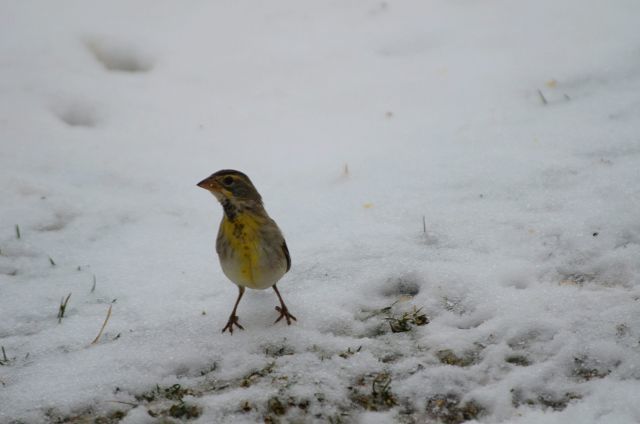Rare in winter, a Dickcissel visits a birdfeeder east of Berlin
- Michelle Wood: SWCD
- February 20, 2012
- 506
Even during the summer, Dickcissels are unusual in our part of Ohio and it is extremely unusual to find one during the winter. I checked Kenn Kaufmans book, Lives of North American Birds, and he writes that a few may spend the season at bird feeders in the northeast.
As breeding birds, Dickcissels nest through the middle of the country, from the Dakotas south through Nebraska and Kansas to Oklahoma and the northern half of Texas, and east to Indiana/Ohio and south to eastern Alabama. Ohio is on the eastern edge of their range, which explains why they are more unusual here.
Kaufman reports that Dickcissels used to nest commonly along the Atlantic seaboard but disappeared during the late 19th century, only to reappear in small numbers since the 1920s. When I lived in northern Indiana, I remember that Dickcissels were also sporadic nesters in that area - some years there were good numbers and other summers we couldnt find them.
Males arrive about a week earlier than females and sing to defend their territory. This is a good time to study them since they are often easy to approach. Males may also have more than one mate. Nests are on or close to the ground, usually in dense growth. The nests are built by the female. She also feeds the nestlings, which leave the nest after seven to 10 days, although the young birds may not be able to fly for several more days (Kaufman).
Each fall, Dickcissels migrate, sometimes in large flocks, south to Mexico, Central America, and the northern tier of countries in South America. Some of these birds migrate through the Caribbean while others fly down through Mexico.
When I received a call about the Dickcissel, I drove out to the farm on Weaver Ridge Road east of Berlin. The bird had been seen by several people earlier in the day but didnt show up during the hour I was there. The following day I stopped by again and this time was in luck. As is often the case, the Dickcissel came to the ground feeders with a flock of House Sparrows, where it fed on cracked corn.
If you are interested in trying to see this rare winter visitor, call the Bobolink RBA to find out if it is still being seen, 330-763-5119. With the continued mild weather, returning birds may show up ahead of schedule. Already, Killdeer have been calling from the Killbuck wetlands and I heard a Red-winged Blackbird singing near our place. Spring is on the way.
Good birding!




